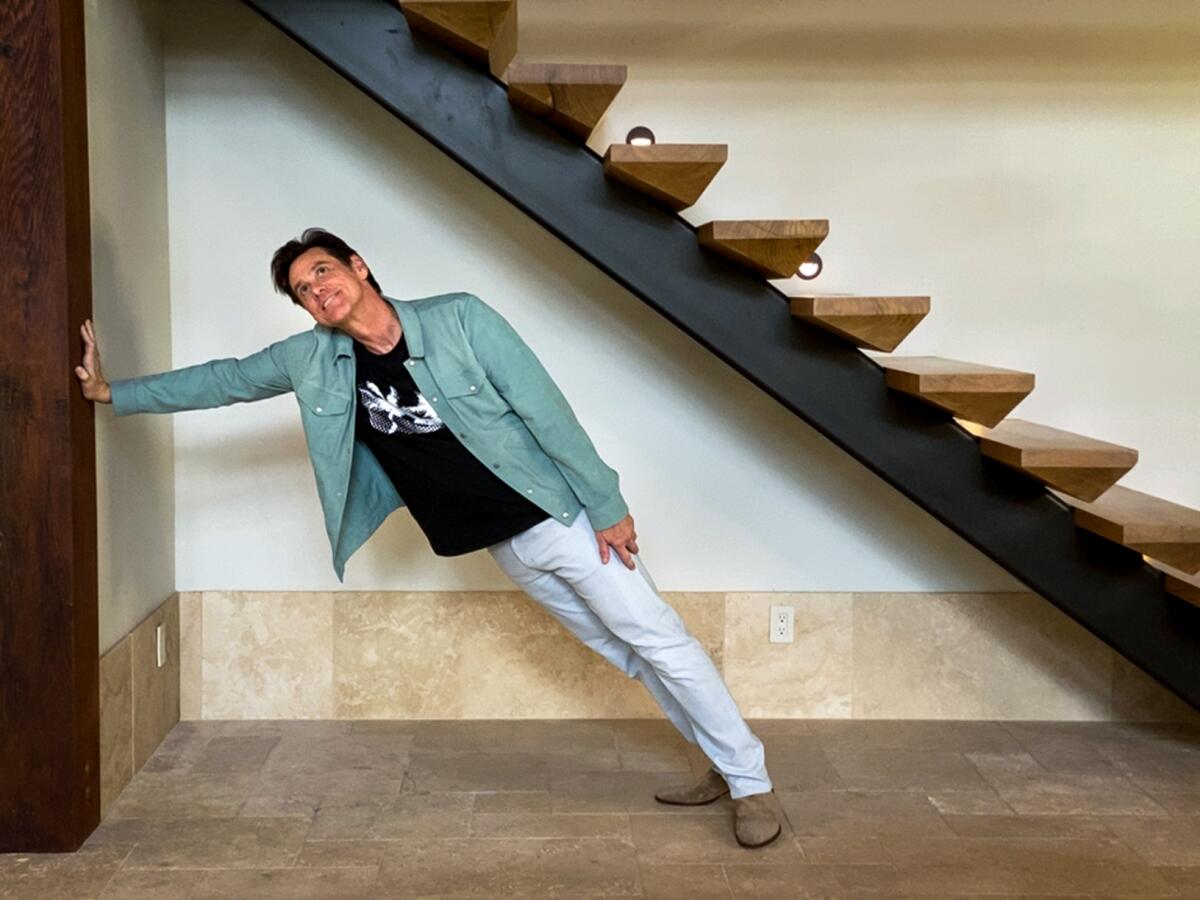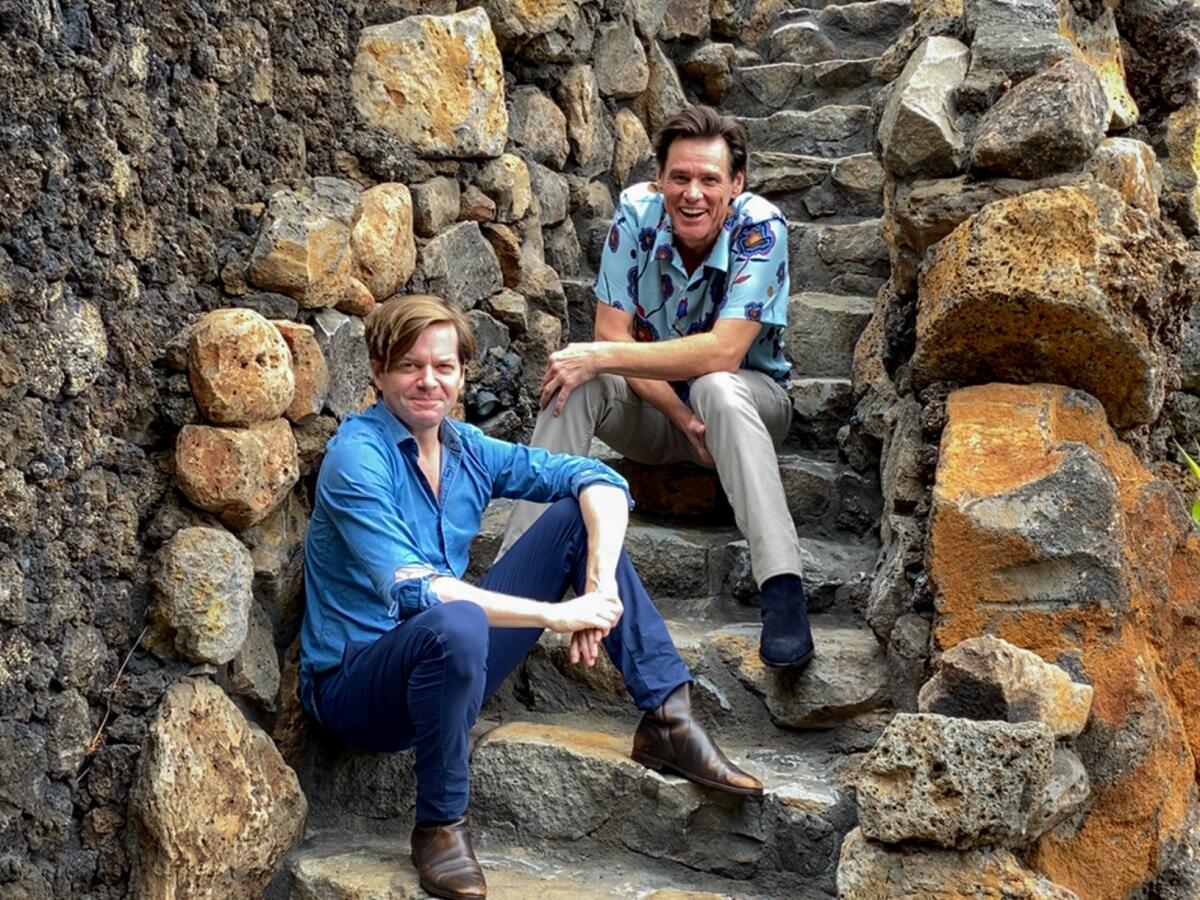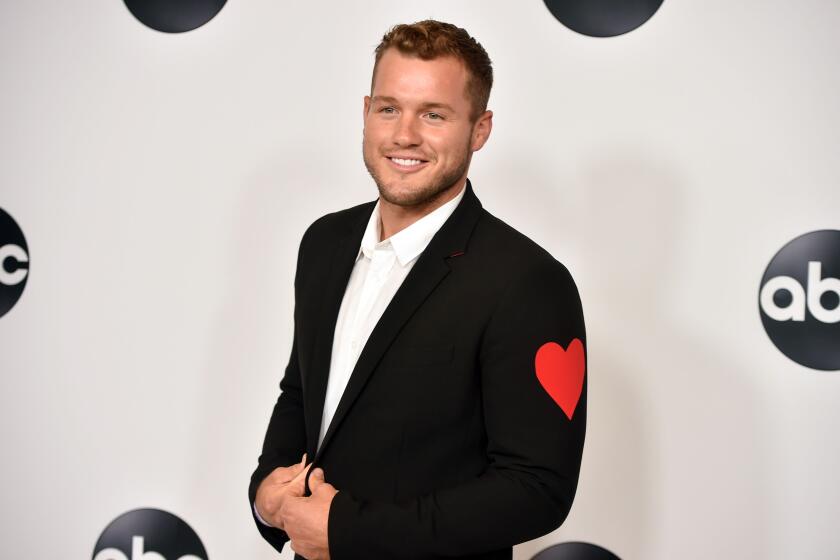What Jim Carrey realized when he thought he had 10 minutes to live

- Share via
In Jim Carrey’s new semi-autobiographical novel, “Memoirs and Misinformation,” there are flying saucers and a fire-bombing on Rodeo Drive, apocalyptic fires devouring Malibu and a mega-budget Hungry Hungry Hippos movie written by Kenneth Lonergan. One moment, “Carrey” dreams of strangling his late mother; the next, he pines for Renée Zellweger (“his last great love”) and challenges Nicolas Cage, a man “whose artistic bravery had always given him courage,” to a jujitsu duel. (Warning: Cage fights dirty.)
Cowritten with novelist Dana Vachon in the third person to capture what Carrey calls the “wholeness that has an infinite knowledge of all of its parts,” “Memoirs and Misinformation” is, like the twisted political drawings Carrey posts on Twitter, entirely its own thing. A satire of Hollywood’s self-absorption coinciding with the end of the planet, none of it is real ... except when it is. And given the extreme circumstances that have marked Carrey’s life, it’s sometimes difficult to sort out fact from fiction.
When Sonny Mehta, Alfred A. Knopf’s late publisher, bought the book several years ago, he wrote Carrey a note, congratulating him for steering clear of “‘There is a town in North Ontario’ bull—,” referencing the opening line from Neil Young’s autobiographical song “Helpless.” “Memoirs and Misinformation” is a deconstruction of the standard-issue show biz chronicle. There aren’t any fun anecdotes about the making of “Dumb and Dumber” or “Ace Ventura: Pet Detective.” Instead, there is a wholly strange work of autofiction, laden with symbolism and metaphor, sometimes beautiful, sometimes tragic, often inscrutable.
In a recent FaceTime call — with Vachon first joining, followed by another good hour one-on-one — Carrey, 58, says he didn’t want to write a memoir that dryly cataloged his life. “You can tell a lot about somebody through their fictional choices,” he says, with Vachon adding that they wanted to use heightened reality to create a “super-position of truth.”
That reality, as you might expect from Carrey’s career of infiltrating fiends, clowns and sad men trying to stave off loneliness, naturally tilts toward the surreal — a tone consistent with the experience of speaking with Carrey himself. For instance, when the conversation turns to Las Vegas, a place the book’s “Jim Carrey” fears he’ll wind up “when he’s old, jowly with bleached teeth and hair plugs, whoring for the bingo crowds,” Carrey describes his own visits to Sin City in feverish prose that surpasses the book.
“Whenever I go to Vegas, I go crazy,” Carrey says. “The only way I can live there is if I put all the faucets on scalding hot so the room becomes some sort of terrarium for tropical plants where literally you can’t see out the windows after awhile. They’re just bleeding with sweat. It’s what I imagine living on Mars is going to be like. ‘I don’t give a damn how you think you’re controlling my environment! I’m going tropical!’ I might have to break a window at some point to stick my head out.”
In his new book, Colton Underwood — who was recently diagnosed with coronavirus — talks about being manipulated by producers on “The Bachelor.”
“Memoirs and Misinformation,” which Carrey describes as “burning myself to the ground and telling you that’s not who I was anyway,” began its life eight years ago when Vachon walked into Carrey’s West Village artist workspace, checked out his paintings and thought, “There’s a story here.” In one corner, there was a depiction of Malibu engulfed in flames. In another, a self-portrait had been slashed. Vachon told Carrey that the scene reminded him of Aeneas standing in Juno’s temple, lamenting the hardships of his life.
Instantly, a friendship was born.
Early in the collaboration, Carrey spilled his life story — his family’s financial struggles, his mother’s pain-medication addiction, his eight-hour shifts at a tire factory, his father’s “sweet, incredible soul,” his stand-up days in Toronto and his meteoric rise to fame — so that Vachon could upload those memories before composing the fictionalized “Carrey.” They Skyped constantly, Carrey spewing ideas, Vachon struggling to turn them into cohesive prose. That process continued regularly for nearly a decade, ending only in February with a final draft. The book was originally set for a May release with an accompanying promotional tour, but the COVID-19 pandemic scuttled those plans. It’s now due July 7.

“We’re still not sure it’s done,” Carrey says, only half-joking. Adds Vachon: “The book is the product of an epic, open conversation. Who spends eight years on a project? To me, that was a gift.”
Writing, Carrey says, felt like “somebody opened the doors of an ancient temple for me.” What he saw inside — and what he wished to convey — can be glimpsed in the image on the book’s cover. The painting, by Carrey, incorporates a photo accidentally taken of him in Maui in 2018 when an early-morning emergency alert warned, by mistake, of an incoming ballistic missile attack.
“My assistant, Linda, called me and said, ‘Chief, we have 10 minutes,’ and I said, ‘What do you mean?’ And she said, ‘The missiles are coming.’ And she was squeezing the phone and accidentally took a screen shot,” Carrey says. “That’s the cover of the book, my actual face after being told I had 10 minutes to live.”
After initially trying to reach his daughter from Maui, Carrey walked outside, sat on the lanai and spent eight minutes going through a “gratitude list.” Staggered by the bounty of his life, he reached a state of grace, closed his eyes and waited for the missiles.
“Now, I walk around the world knowing what that is for me, and if that should happen, where my head’s going to be,” Carrey says haltingly, wiping away tears. “I’ll sit and thank God for the blessings in my life. If I was anybody, who was I? And I don’t really believe that I’m anybody. I believe there’s nothing that isn’t you.”
Memoirs by Kiese Laymon and John Edgar Wideman; essays by Darryl Pinckney and Mikki Kendall; masterpieces from Michelle Alexander and Claudia Rankine.
“Memoirs and Misinformation” features a comparable apocalyptic accounting, with similar results. Yet the real Carrey has been anticipating oblivion for most of his life. In the book’s sixth chapter, our hero goes to the Saharan Motor Hotel to meet screenwriter Charlie Kaufman to discuss playing Mao Zedong in a biopic that “Carrey” believes “will be his ‘Raging Bull.’” It’s the same seedy Sunset Boulevard lodge Carrey checked into in 1982, freshly arrived from Toronto with just a suitcase of clothes and a second-hand copy of Hal Lindsey’s doomsday bestseller, “The Late Great Planet Earth.”
“I walked through a parade of hookers and took my little green ass to some motel room that would make Baretta jealous,” Carrey says. “And I’m reading this book saying the world is going to end soon and I’m like, ‘But I just got here. I gotta make it before I die.’ So, literally, I’ve been making it before I die for almost 40 years. But we all have the sword of Damocles over our heads. That mushroom cloud is a character in our lives. And we have to learn how to dance and smile and do all the proper and appropriate things.”
Dave Holstein, creator of the Showtime series “Kidding,” starring Carrey as a children’s television personality coping with tragedy, believes his star has reached a tenuous peace with a life of “peaks and valleys we can only begin to understand.”
“When you go to enough therapy your whole life, you eventually become your own therapist ... and I think Jim has mastered the art of self-study,” Holstein adds. “He’s so unsatisfied, in a way that most incredibly ambitious people are, that there’s always something they feel they can accomplish that they haven’t yet done.”
The two seasons of “Kidding” survey similar ground as “Memoirs and Misinformation,” picking at family wounds, excoriating celebrity and mulling mortality, engaging in what Holstein calls a “full-throttled emotionality.”
“He is sensitive,” Holstein says, “and not afraid to really tap into the raw, honest feelings that we go through in the dark.”

Midway through our FaceTime conversation, Carrey says he wants to show me something. Scrolling through his phone, he lands on a drawing he’s making of his father, Percy, wearing a navy suit, the only suit he ever owned. It’s a work in progress, illustrating a scene from the book in which Percy holds his son’s wounded hands (which “Carrey” had gnawed away in a fever dream, thinking they were Slim Jims) and reveals nothing less than the meaning of existence.
“There is one spirit guiding all things,” the father tells the son. “The universe, one verse. The stars and the sea and the wind through the wheat fields. And us, you and me. Once through flesh. Now through memory. See? I’m in you and you’re within me.”
“It’s Dad to the rescue,” Carrey says softly, looking at the image. “At a certain point, when you’re at your lowest, those are the voices that you go to, the people that taught you how to live.”
He puts the phone down. The house is quiet, and neither of us wants to break the spell. “There’s freedom in creating, man,” Carrey finally says. “I swear to God, I couldn’t live without it. I’m drawing my father, and there’s joy because I’m remembering my dad, how hurt he was in life, but still what a beautiful gentleman and joyful soul. Creating these things makes me happy.”
It’s all in the book, he continues. “I said a lot of things I want to convey. About my way of thinking. About going down a red carpet and seeing an almost Wile E. Coyote blueprint of the physical bit I’m about to do for people. How I’m inspired that way. How I feel every time I tell a joke or take a chance on humor, no matter what it is, it’s like being a cliff diver and hoping you timed it right so the tide is in when you hit the water.” Carrey pauses and then, slowly, that elastic smile that has sold millions of tickets over the last quarter century washes over his face. “But you never really know if you’re going to hit the rocks.”
Over the last three months, 17 writers provided diaries to the Times of their days in isolation, followed by weeks of protest. This is their story.
More to Read
Sign up for our Book Club newsletter
Get the latest news, events and more from the Los Angeles Times Book Club, and help us get L.A. reading and talking.
You may occasionally receive promotional content from the Los Angeles Times.










